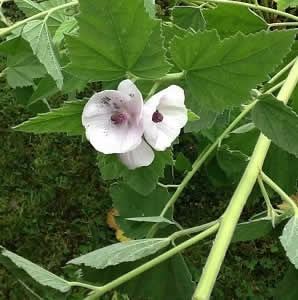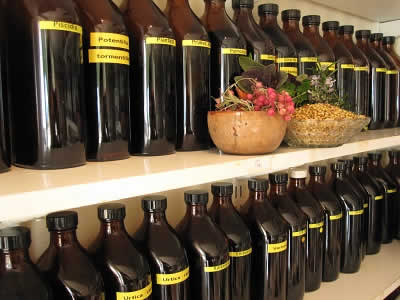Positive Health Online
Your Country

Marshmallow the Most Soothing of Herbs
listed in herbal medicine, originally published in issue 213 - April 2014
Marshmallow (Althea officinalis) is a handsome and stately perennial from the Malvaceae family, with soft velvety leaves and pink flowers. As its name suggests, it is found growing wild in salty sea marshes in Europe and Western Asia. Its botanical name Althea comes from the Greek meaning “to cure”, as it was known to ease so many ills.

Marshmallow officialis
The roots, leaves and flowers are all used medicinally. The abundance of mucilage, particularly in the root, gives it a sweet taste and heavy, sticky and cooling qualities, and makes marshmallow the most soothing of medicines. It is wonderful for relieving irritation and inflammation; the tannins heal irritation, inflammation and ulceration of the mucous membranes, and the flavonoids and salicylic acid have anti-inflammatory properties. It also contains sterols, coumarins, phenolic acids and amino acids.
Traditional Uses
The use of marshmallow as a nutrient and medicinal herb originated in ancient Greece and later spread into Arabic and Ayurvedic medicine. The Greeks ate the tender leaves and young tops, the Egyptians and Syrians grew it as a food and the Romans enjoyed the root as a vegetable; Aristophanes spoke of eating mallow shoots instead of wheat. Followers of Pythagoras considered mallows sacred, as the flowers always turned towards the sun. Pliny said “whosoever shall take a spoonful of the Mallows shall that day be free from all diseases that may come to him.” In Palestine, according to the Book of Job (Chap.xxx ver. 4), the plant was eaten by the poor to eke out their food: “Who cut up Mallows by the bushes and juniper roots for their meat.” Later Gerard said: “The leaves be with good effect mixed with fomentations and poultices against pains of the sides of the stone and of the bladder; also in a bath they serve to take away any manner of pain.”

Herbal Medicines
Modern Medicinal Uses
The mucilage (glucans, arabans, galacturonic rhamnans) in marshmallow is a thick, slimy substance that coats, protects and soothes the mucous membranes throughout the gut, especially when used in cold infusion. It is not digested and remains unaltered until it reaches the colon, explaining it efficacy in treating inflammatory gut problems. It can relieve heartburn, indigestion, gastritis, peptic ulcers, IBS, ulcerative colitis and Crohn's disease, as well as constipation caused by dryness; it also reduces excess peristalsis and can relieve diarrhoea. It is a helpful aid to radiologic oesophageal examination, preventing irritation and inflammation, and can aid blood sugar management in diabetes. Its antimicrobial action has been found to be effective against E. coli, useful in gastro-enteritis and dysentery, and for treating dysbiosis (disturbance of the gut flora).
Marshmallow acts as a soothing expectorant and can be useful for harsh, dry coughs, sore throats, laryngitis, croup and bronchitis. It also helps to clear catarrh. Its anti-histamine properties are helpful in easing allergic conditions such as hay fever and asthma, especially where there is inflammation in the bronchial tubes. In the nineteenth century a medicinal sweet was prepared using marshmallow juice, egg white and sugar, and used to soothe children’s sore throats. Similarly French pharmacists used to prepare a famous medicinal sweet known as Pate de guimauve from the roots to ease teething problems in babies. The modern marshmallow sweets unfortunately do not contain anything of the plant or its constituents.
With its soothing and diuretic constituent asparagine, marshmallow is also useful in treating cystitis, urethritis and irritable bladder, and was a traditional remedy for easing the passage of urinary gravel and stones.
Marshmallow enhances immunity, and stimulates production of white blood cells; it is antimicrobial against Proteus vulgaris, Pseudomonas aeruginosa, and Staph. Aur. and helps ward off and treat respiratory infections. An evaluation of the antibacterial actions of 16 herbal tinctures and their effect on E. coli infection demonstrated that marshmallow affected microbial metabolism.[1] A study in Italy showed the antibacterial activities of marshmallow against many anaerobic and aerobic periodontal bacteria.[2]
Its abundance of minerals and vitamins make marshmallow a useful tonic when run down after illness, stress or surgery. It contains beta carotene, calcium, iron, magnesium, manganese, phosphorus, potassium, selenium, zinc, vitamins B1, B2, B3 and C. It is considered to be strengthening and rejuvenative; research has demonstrated that marshmallow has antioxidant activity,[3] probably related to its tannin and flavonoid (kaempferol, scopoletin, quercetin) content. Marshmallow was traditionally added to formulae to ease childbirth and to enhance the production of breast milk.
The soothing and healing properties of marshmallow can be applied externally. The leaves can be rubbed on to insect bites and stings, and applied to scalds, burns, sunburn and skin rashes to reduce irritation and inflammation. Marshmallow soothes and heals inflammatory skin problems including acne, eczema and sore nipples. A warm poultice of the leaves or pulverized root helps draw out splinters, and can be applied to mastitis, breast abscesses and boils, as well as joint and muscular pain, bruises, sprains and strains. A gargle can be used for sore throats, tonsillitis and mouth problems such as ulcers and spongy, inflamed gums. The root can be gnawed by babies to ease teething. A decoction of the root makes a soothing lotion for bathing inflamed eyes.
Marshmallow is considered safe and virtually no side effects have been reported. It may cause low blood sugar in some people. The mucilage may reduce absorption of prescription drugs and supplements; take six hours before or after other medication.
References
1. Watt K, Christofi N, Young R. The detection of antibacterial actions of whole herb tinctures using luminescent Escherichia coli. 21(12):1193-9. Pollution Research Unit, Applied Research Centre for Health, Environment and Society (ARCHES), Edinburgh, UK. Dec 2007.
2. Iauk L, et al, Antibacterial activity of medicinal plant extracts against periodontopathic bacteria. Phytother Res.;17(6):599-604. Jun 2003.
3. Kardosova A, Machova E. Antioxidant activity of medicinal plant polysaccharides. Fitoterapia. 2006 Jul;77(5):367-73. Epub May 24 2006.
Comments:
-
No Article Comments available